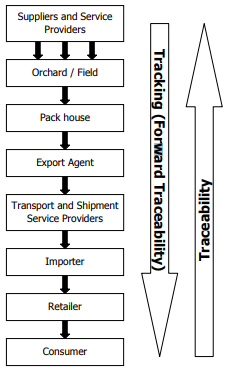Supply chains exist in production, manufacturing and service organisations, and they are principally concerned with the flow of products and information between supply chain member organisations. Supply chains are concerned with processes such as the procurement of products (sourcing), their transformation into finished products (production and packing), and distribution of that product to consumers. An agricultural supply chain is a series of distinct activities that take place in order to take the product from field or orchard to market. The demand chain is the supply chain in reverse, seen from the consumer’s point of view. The following diagram shows a supply chain where exporting is part of it:

Fresh Produce Supply Chain
Tracking: Tracking is the ability to follow a path of a specified unit and/or batch of products through the supply chain as it moves between organisations towards the final point-of-process, point-of-sale or point-of-service. Tracking is also referred to as forwarding traceability.
Tracing: Tracing is the ability to identify the origin, movements and relevant associated information of a particular unit and/or batch of product located within the supply chain by reference to records held upstream. Tracking is also referred to as backward traceability.
In order to meet consumer demands for a consistent supply of top quality, safe and nutritious foods, the design and implementation of full backwards and forward traceable supply chains from farm to end-user has become an important part of the overall food quality assurance system. Farmers, post-harvest handling operators, marketers, researchers and policymakers need a sound understanding of the concepts and implications of supply chain traceability to assist in developing and implementing appropriate
Elements of Traceability
Traceability adds value to the overall quality management system by providing the communication linkage for identifying, verifying and isolating sources of noncompliance to agreed standards and customer expectations. On previous levels, we examined traceability in its obvious and simplistic form, but it is important to remember that traceability has many different elements. Some of these elements are directly related to the Good Agricultural Practices (GAP).
There are six important elements of traceability, which in combination constitute an integrated agricultural and food supply chain traceability system. They are:
Product Traceability - Product traceability determines the physical location of a product at any stage in the supply chain to facilitate logistics and inventory management, product recall and dissemination of information to consumers and other stakeholders.
Process Traceability - Process traceability ascertains the type and sequence of activities that affect the product during the growing and post-harvest operations, meaning what happened to it, where and when. These include interactions between the product and physical, mechanical, chemical, environmental and atmospheric factors and the absence or presence of contaminants.
Genetic Traceability - Genetic traceability determines the genetic constitution of the product, which relates in terms of food production to the plant material that was used in the orchard.
Input Traceability - Input traceability determines the type and supplier of inputs such as fertiliser, chemical sprays, irrigation water, and the presence of additives and chemicals used for the preservation of the product.
Disease and Pest Traceability - Disease and pest traceability trace the epidemiology of pests and biotic hazards such as bacteria, viruses and other pathogens that may contaminate food.
Measurement Traceability: Measurement traceability relates individual measurement results through an unbroken chain of calibrations to accepted reference standards. To achieve this, measuring and test equipment and measurement standards are calibrated utilising a reference standard whose calibration is certified as being traceable to a national or international standard.
The other aspect of measurement traceability relates to the property of the measurements, including data and calculations, generated throughout the supply chain and their relationship to the requirements for quality. By focusing on the quality of measurements, rather than on a property of an instrument, it is possible to assure that the measurements are indeed adequate for the intended use. To achieve this, each measured data must specify the environmental, operator, and geospatial and temporal factors, which are not related to the instrument but impact the quality of the data.